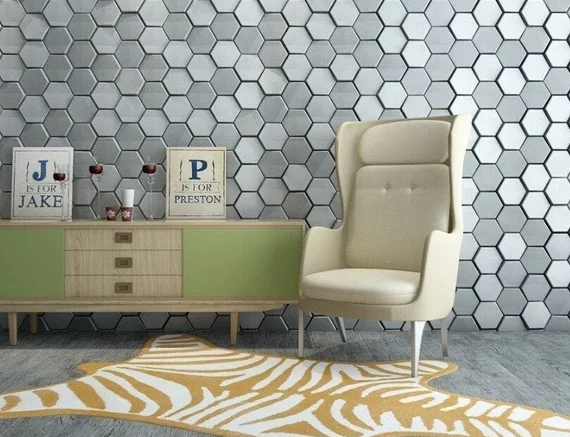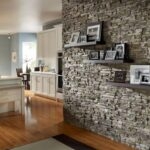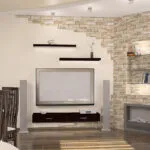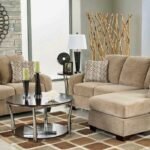
Sound is important in design. The function of a space is not only determined by its aesthetics but also by the sounds it makes.
“Sound may be invisible or only inadvertently perceived, but that does not make it a less architectural material than wood, glass, concrete, stone, or light”.
The sound becomes inextricably linked to the function. But since design starts first on paper, we won’t figure out how to get rid of noise until we populate a room.
The growing popularity of decorative acoustic felt panel installation proves that balancing acoustics in space does not have to conflict with original design elements. Although one size does not fit all when it comes to acoustic treatment, polyester acoustic panel is proving to be the material of choice for acoustic felt panels in the design industry.
Polyester Sound Absorbing Panels are made of 100% polyester by needle punching. The production process is completely physical and environmentally friendly, without sewage, emissions and waste. Without glue, the porous nature of the acoustic panel makes it sound-absorbing and heat-insulating.
Of solution’s sound-absorbing recycled polyester panels with sound-absorbing insulation performance, uniform hard materials, flexibility, strength, abrasion resistance, impact resistance, tear strength, easy cutting, and large panel width, will surely be the ideal sound insulation materials and decoration materials. Bring you a quiet and elegant environment.
What is polyester acoustic panel?

Polyester felt is made of recycled PET plastics, mostly water bottles or other single-use products. The recycled material is compressed and melted down until left with plastic flakes. The plastic bits are then remelted and extruded as fiber. This fiber is then used to produce rolls or sheets of PET textile material, similar in any felting process. It can contain anywhere from 0% to 100% recycled content. Not only is it sustainable, but it is fast becoming the premium choice for sound dampening performance in lieu of other traditional materials, like fiberglass.
Polyester felt’s lightweight durable nature (combined with an additional lower melting point ) create the ideal properties for acoustic felt panel design. Its capability to be easily cut, variety of color options, and limitless forms are making polyester acoustic panels part of the visual landscape in modern interior design.
Benefits of Using Polyester Felt in Acoustic Insulation

When we design for sound, we are designing for experience. Before, implementing sound insulation into already existing spaces meant the only solution was to hang unattractive hanging baffles and deal with the eyesore.
Now, polyester felt delivers an appealing design in junction with high-functioning performance rates of acoustic insulation.
There is a symphony of reasons the design industry is choosing polyester acoustic panel over any other material; acoustically, environmentally, and aesthetically.
Excellent Acoustic Performance
While it is possible, it is challenging to include acoustic design into a space before it has been occupied. In most cases, sound is the last piece an architect will fit into the puzzle. Knowing how a room will be used and where the potential challenges will be for sound issues are essential pieces of the puzzle to negotiate when implementing acoustic solutions. The building layout may not be flexible, but the acoustic solutions can be.
Polyester acoustic panel soaks up ambient noise in a variety of forms. Do you need to mitigate noise in your office conference room? Consider hanging acoustic clouds strategically over spots where noise reflection is at its highest. Are your gym guests experiencing an overload of noise in a large open floor plan? Ceiling baffles would work best here, especially when dealing with higher ceilings.
Using polyester acoustic panel to your best advantage involves finding your key sources of noise and adopting different paneling styles to adapt to the parameters that will help aurally orient your space.
Appealing Function in Design
If, as Kimmerman claims, sound is as vital as wood is for building framing, how far can we take acoustic solutions? Structural possibilities with PET are far-reaching. Its flexible form can be bent, molded, and shaped to any design for an assortment of interior applications, including furniture and lighting fixtures. Designers can exercise creative freedom with a host of different color options and texture choices (dependent on manufacturing methods).
Felt itself is a nuanced fabric that works to your elemental design. You can play it safe and subtle, blending your acoustic felt panels into the background or creating statement pieces that accentuate your already developed design theme. Acoustic insulation can be as simple as under-carpeting or as intricate as 3D ceiling baffles.
Ultimately, polyester felt complements a space without compromising it.
The Sustainable Choice
It is estimated that Americans alone throw away upwards of 35 billion plastic bottles a year. And subsequently, roughly 8 million tons of plastic end up in our oceans. But a major culprit of waste is the textile industry adding billions of pounds of waste to our landfills and depleting energy and water resources.
Reworking the end-use for so many single-use plastic products (and the proposed 95% of all textiles that do have the potential to be recycled), PET is the friendliest raw material in textile applications (among other industries) as well as the healthiest.
Polyester acoustic panel needle punch felt is manufactured without the demand for any chemical additives like glue or resin to bond the fibers. Furthermore, polyester felt does not give off VOCs or odors. This makes it safe for indoor use (able to meet building standards and certifications) while requiring fewer energy resources in the manufacturing process.
The amount of recycled content in PET material can vary from 0% to 100%, depending on the providing manufacturer’s specs and the customer’s desire for a “greener” source. It is not only recyclable at the end of its life but possibly reusable dependent on its modularity.
Designing for the Ears
The acoustic properties of a space have a significant impact on its residents. Managing unwanted noise by integrating acoustic solutions promotes your community’s overall wellness and health, whether it be at home or in your commercial office building.
In the acoustic design process, custom is the standard. Finding the best product for your project starts with making the quality choice of polyester felt. At BIT, we manufacture 100% polyester acoustic panels under our Poly-Sonic line. Each panel has a recycled content of at least 60% PET plastic and is made entirely in the US in our facilities.
Poly-Sonic acoustic felt provides fantastic sound quality that is available in any weight, thickness, or color necessary to meet your specialized products’ demands. We also provide rolled goods that can be molded into any form of acoustic panel solutions or used as a wrapping fabric for other soft-touch surfaces, so the design process is entirely yours.
Sound is undeniably a very important aspect of our existence. Aside from being a major form of communication, it’s also put to task in geophysics; in aspects of signalling, location and positioning. As energy, it can be used to break down solids and degas liquids. Sound waves are as a result of vibrations between atoms or molecules. These vibrations are converted from kinetic energy to sound energy. It’s this energy that enables the sound waves to be propagated.
Despite its vast applications and usefulness, this form of energy is sometimes unwanted and becomes a nuisance or hinderance. The noise of a motor engine, external noise in a music studio, noise from a shared apartment etc. There is therefore need for a means or technique to reduce or block it. Since they are waves, sound energy can refract, reflect and maneuver around edges. Although they cannot be completely blocked, they can be greatly reduced. The act of eliminating, reducing or blocking sound is referred to as sound proofing, which can be done in the following three basic ways:
- Distance: When traveling through a medium e.g air, the sound energy of the waves is gradually lost converted to vibrational (kinetic) energy in the atoms of the medium. As a result, the longer the distance the waves have to travel to reach the receptor, the more of its energy is lost.
- Absorption: Absorption and/or damping are complex forms of soundproofing, through the use of materials. In absorption, soundproofing is achieved by the reduction of the energy of the sound waves. When sound waves hit any surface, some get transmitted through the material, some get absorbed within the material and a percentage gets reflected (depending on the absorbing quality of the surface). The sound energy is converted to kinetic energy through vibrations, and finally to a miniscule amount of heat, through inter molecular friction.
- Damping: A form of absorption in which the oscillating sound waves are made to undergo resonance, with respect to the surface it hits. damping works best at low frequencies.
One might imagine that soundproofing can be achieved by any material, this is however, far from the case. There are a few materials that can effectively carry out soundproofing. Before studying some of these materials, we need to first get an understanding of what properties make these materials unique.
- Density. Density is the amount of mass per volume of a substance. It is measure of how packed together, the molecules of a material are. For a material to be sound proof it has to fall within a proper density range. High enough and sound waves get damped; low enough and they get absorbed. If the material’s density is too low, the sound waves are transmitted through. If the density is too high, the waves get reflected off the material’s surface.
- Porosity. This property involves the use of intersiticies to alter the energy of the sound waves by expansion, compression and change in the direction of flow; resulting in loss of momentum. Porosity is an advantage in absorption and a disadvantage in blocking.
- Flow resistivity. This is the flow resistance to noise per unit thickness of a material. It is the most important characteristic of sound absorbers. Resistivity is dependent on tapers of the sound waves.
- Cell size. The individual cells of the material, have to be adequately small for the material to qualify for soundproofing. The cell size of the material must be smaller than the wave length of the sound it is meant to absorb or block. Cell arrangement is also of importance. Open cell arrangement make better absorbers, while closed cell arrangements make better blockers.
- Tortuosity. This is a measure of the twists and turns in the material’s cell arrangement. The more bends the sound waves have to maneuver, the more momentum they loose.
The above properties qualify a material as good for soundproofing. let us now take a look at some unique, soundproofing materials.
- Polyurethane foams. Acoustic foams were first used in the mid 1970’s. Polyurethane foams are made through basic addition polymerization reaction involving a diol or polyol, a diisocyanate, and water. Acoustic foams have mostly open cells as a result of trapped gas bubbles which pop. Air passes easily, through this type foam. Polyurethane is designed as a flexible, open-cell, porous solid. Sound energy is propagated through the material by two major methods:
- Sound pressure waves move through the fluid within the pores of the polyurethane
- Elastic stress waves are created as a result of the pressure waves, which are carried through the frame of the polyurethane
Polyurethane is quite effective at attenuating high frequency sound waves, but it does not provide low frequency isolation unless sufficient thickness is used. The porous nature of polyurethane greatly reduces acoustic reflection, but this low density also allows for the transmission of sound energy. Acoustic foams are chemically inert but flammable. Because of its flammable nature. Polyurethane foams cannot be used in industries. It is more suitable for installation within a room.
- Felt is produced by pressing and matting fibers together. Fibres use may be natural (mostly wool) or synthetic. A blend of both is also common. Felt is durable and stable in the presence of moisture, lubricating oils, greases, salts, detergents, and is inert to many other chemicals. Its ability to bend to uneven surfaces prevents the unwanted intrusion of foreign substances beneath the load-bearing area. Felt possesses almost permanent resilience, as it is made up of millions of individual fibers. The performance of felt in sound absorbtion is as a result of its optimum density and spring. The absorption of sound waves is achieved by the vibration of individual fibres within the felt. The energy is dissipated by frictional heat loss. Due to its method of absorbtion, too dense felt would not allow for sufficient vibrations .These qualities make it excellent for industrial sound proofing. Felt is also used as a damper in musical instruments.
- Polyester acoustic panel. Polyester fibre is a man made fiber, made up of long chain synthetic polymers. They are generally known as non woven or bonded fibre fabric. They are used to make non toxic, light weight insulation products. Polyester fibre is spectacular for it’s unique blend of heavy density (approximately 2000g/m^3) and porosity. It’s sound absorbtion increases with the frequency of the sound, hence it’s most effective at high frequencies. It’s NRC rating is between 0.8 and 1.Polyester acoustic panel is also strong with high tensile strength. Other desirable properties are it’s resistance to abrasion, fire, wrinkles, stretch, impact and wear. These properties make it an excellent soundproofing material in industrial and heavy machinery settings.
- Fiber Glass. Acoustic fiberglass has the desirable combination of rigidity and being light weight. Popularly dubbed, the shape shifter of sound proofing, this material can be very easily customized, to allow for installation in the tightest of places. Glass fibre is mostly used in rooms and halls to prevent reverberations and echos.
- Mass Loaded Vinyl has been applied in soundproofing since the 1960s. It is basically a viscoelastic material, such as polyvinylchloride, that is infused with an inert material, like calcium carbonate or barium sulfate. Viscoelastic materials exhibit both viscous and elastic properties. They will flow, but when the force is removed or reversed, they will go back to their original shape. This attribute, known as hysteresis , contributes to the ability of MLV to attenuate sound. It is this mechanism by which many claim that MLV “converts sound to heat”, although it is not the fundamental mean by which MLV attenuates sound. MLV basically acts like a tuned mass damper, capable of reducing the frequency of waves. When vinyl is exposed to low temperatures, it becomes very hard, but when it is exposed to high temperatures it becomes very compliant. When the elastic component becomes very stiff, the vibration modes of the sheet are tuned to a higher frequency, affecting its ability to attenuate sound at lower frequencies. As is the other way round, as the temperature increases, the MLV becomes limp, to the point where it doesn’t possess enough compliance to vibrate. Plasticizers can be used to ensure the proper compliance of the MLV over the operating temperature range. This material is very flexible and suitable for corners and bends. It’s however, expensive.
- Cork. is an amazing natural alternative for soundproofing. It’s the phellem layer of bark tissue, harvested from the cork oak. This material is fire proof, elastic and impermeable to an extent. Cork is so effective in soundproofing, that just 3mm of the material blocks 10decibels of sound. This amazing ability is as a result of the very cell structure and composition of the cork. Air is a great insulation material and cork is made up of 50% air. This makes it very light, with a density of 0.16g per cubic centimeter. The cells of these material are arranged as in the honey comb with each cubic centimeter meter containing an average of 40 million tiny air sealed cells. When sound energy passes through cork, the energy is converted to vibrational energy in by the air molecules. Cork is able to trap an immense amount of air molecules and this makes it an excellent insulator of sound.
- Green glue. is a viscoelastic compound that insulates sound using the constrained layer damping (CLD) system. The glue is applied (sandwiched) between two rigid materials like dry wall. In CLD systems damping occurs when the viscoelastic material is sheared. When sound waves hit the rigid material, it causes it to shift in different directions. This movement results in shear forces within the green glue. The polymeric design of green glue, enables it to convert the energy from the shearing, to frictional energy, and therefore heat. Green glue is not toxic; but despite the name, it does totally work as an adhesive.
- Silicone. is a good soundproofing option for tight spaces and corners. Silicone, also known as polysiloxanes has many desirable properties. It’s is mostly inert, has low thermal conductivity, is resistant to water, UV rays and provide air tight insulation. Silicone has applications in soundproofing as caulk. It’s applied in a paste form and usually cures to form a rubbery coating. This coating is air proof and so stops sound propagation by air. It’s also a great damping material and is excellent at damping mid frequency sounds.
- Epoxy. usefulness in soundproofing is as a result of its air resistance and damping properties. They are mostly used to supplement other soundproof materials. can be used as adhesive when setting up soundproof material as they are more advantageous that regular glue. can also be applied as coating.





